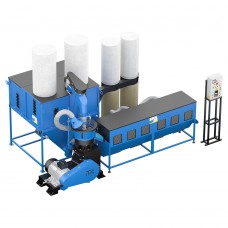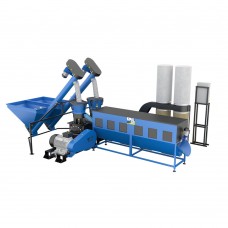Pellet machines for every size - from small pellet machines to complex production lines

Biofuels have become an integral part of the energy landscape in our part of the world. Fuel produced from biomass attracts users with its low carbon footprint, simplicity of use and, until recently, attractive price.
The undisputed leader among biomass fuels is definitely pellets.
Due to fluctuations in market prices, an increasing number of users of the pelletized fuel are opting for its own production.
The theory is very simple - to ensure our energy independence we need biomass and a pellet machine.
However, there is another important factor to consider in this equation - scale.
It's not hard to guess that the pellet production process will be different for a single-family home, different for a medium-sized agritourism, and different for a large, thriving farm.
The pellet machine market, like the automotive industry, offers solutions in each segment tailored to the varying expectations of users.
Before buying a pellet machine, it's worth estimating your needs, so that you don't get yourself a TIR when you only needed a toddler.
Let's find out how to choose the right equipment.
Pellet consumption
Before you start making your own pellets, it is essential to calculate your pellet needs. If you have used purchased pellets so far - you know your consumption. If not, you can easily count them.
You can do this on the basis of your heating bills (e.g. gas, electricity, coal) or estimate your annual demand.
Energy demand is given in kilowatt-hours per square meter, or kWh/m². Depending on the insulation of the house, this figure can vary, most often between 100 and 200 kWh/m².
High-quality pellets have a calorificvalue of about 5 kWh/kg, in the case of homemade pellets with an admixture of, for example, hulls or hay, this value can be lower and oscillate around 4 kWh/kg.
Let's calculate this for a hypothetical house with the following parameters:
area: 120m²
energy demand: 120 kWh/m²
calorific value of pellets: 5 kWh
For such a building, the case would be as follows:
Energy demand:
120 kWh/m² x 120 m² = 14,400 kWh
Pellet consumption:
14,400 kWh ÷ 5.0 kWh/kg = 2880 kg of pellets per year, with a reserve - 3 tons of pellets.
Types of pellet presses
Pellet presses can be systematized on the basis of production capacity given in kilograms of finished pelletsper hour (kg/h).
Pelletizers are also divided into two main types.
Disc presses are by far the most popular type of pelletizer, dominating the market for smaller-scale pellet production - it is to this group that all the models listed below belong. Among disc pelletizers , there are single-axis models , available with two, three or four runners - that is, rotating elements that force the biomass through the holes of the die. The more runners, the higher the productivity of the machine, as the raw material is processed faster and more efficiently.
There are also ring pelletizers, which are specialized machines designed mainly for industrial applications, where high efficiency and continuous operation are required.
Another distinction can also be the type of power supply. Most models available on the market assume operation in a place with constant access to electricity. An alternative to electric presses are combustion pelletizers - more expensive to use, but providing independence from the electrical system.
For the purpose of our comparison, however, let's return to the criterion of production capacity of pelletizers expressed in kg/h.
The comparison is as follows:
1. equipment for domestic use (up to 100 kg/h).
These are small presses designed to produce fuel for the use of a single household.
An example of such a device is the PELLETNIK 150 (60kg/h).
Devices in this segment are characterized by simplicity of construction. Small pelletizers are usually multifunctional presses that can also function as a feed pelletizer (after replacing the die with a coarser one).
They are simple in operation, easy to transport, operating on electricity from a traditional230V "socket".
2. pelletizers for small farms and local producers (100-300 kg/h).
Machines in this class are slightly more efficient pelletizers, profitable for farms generating large amounts of biomass or for smaller wood processing plants.
Machines in this segment also often come in a multifunctional version and, after replacing the die, will successfully perform well in the production of pelletized feed.
An example of such a press is PELLETNIk 260 (capacity: 250 kg/h for pellets and up to 500 kg/h for feed).
3. industrial pelletizers (above 300 kg/h)
This is a segment of pelletizers adapted for processing large amounts of biomass, as well as for continuous operation within a line with, for example, a screw feeder. Most often, they can also function as granulators. Used in large farms, sawmills or carpentry plants.
Recalling the hypothetical pellet consumption of 3 tons per year calculated in the paragraph above - we can estimate that a pelletizer in such a configuration can, during one shift (8h), produce the equivalent of the annual pellet demand for a small insulated single-family house.
An example of such a machine is the PRIME-400 PRO.
4 Pellet production lines (from 150 to 700 kg/h).
Pellet production lines are automated sets of equipment that cover the entire pellet production process - from raw material preparation, through drying and pelleting, to cooling and packaging. Unlike a single pelletizer, which is only responsible for forming pellets, production lines are designed for continuous and larger-scale operation. This does not mean, however, that the line has to be more efficient than stand-alone pelletizers. The advantage of the line is its uninterrupted operation and the automated process of delivering biomass inside the machine.
There are, of course, larger devices whose capacity and size are limited only by the pockets of investors and managements ordering them for their plants. However, these are the devices most often constructed on behalf of large-scale pellet companies. The largest factory pelletizers record capacities as high as 10,000 kg/h.
Summary
Self-production of pellets can take many forms - for some it will be an allotment activity for their own use and that of a few neighbors, for others it will be a cost-effective form of waste management, which would have to undergo disposal in any case. Still others treat the production and distribution of biomass fuels as an important source of income.
Regardless of which group you belong to - before buying a pellet press, familiarize yourself with the different types of equipment and choose the one that best meets your expectations.












